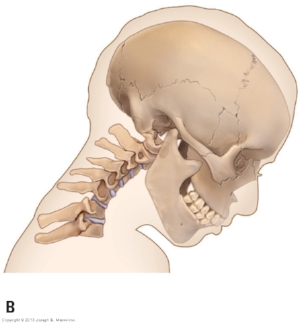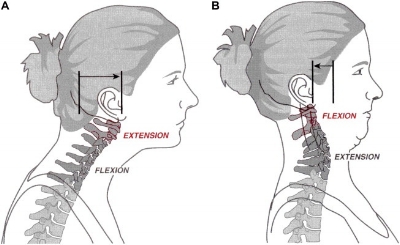Disclaimer: This post discusses potential reasons/causes for neck pain in CrossFit. There are certain instances where slight cervical extension is necessary, i.e. Olympic lifts, and okay for certain people. However, if you are having neck pain, neck related shoulder and arm pain, or want to try to avoid it due to past injuries, etc. then this post is for you!
We talk about protecting the low back/lumbar spine a lot in regards to lifting. What often gets overlooked is the neck. Just like the low back, it is important to keep in a good position while lifting to avoid injury.
Quick Anatomy Lesson
We have 4 natural curves in our spine. Life causes us to move out of these curves and that’s perfectly okay and necessary. There are a lot of differences and anatomical variances person to person and that’s okay too! Therefore, I don’t like to get caught up in “alignment” because
1) there’s nothing we can do about anatomical variances and
2) I don’t feel the need to create fear in my clients by telling them they have lost their cervical curve or they have one hip that’s higher than the other.
Cervical Flexion
Cervical Extension
That being said, when we are lifting/loading our spine or performing a lot of repetitive movements of the spine, we want to maintain these natural curves as much as possible. We’ll talk more about this in a bit.
Moral of the story is = Don’t be afraid of moving out of “neutral” but also be mindful of your position when you are loading your spine.
Your spine should function as a unit and each segment/vertebra should contribute to movement and stability. Sometimes segments move too much and have more stress placed on them than others. We call this "hinging" at a segment versus there being a nice even curve throughout. Over time this can irritate the joint, nerves or discs between the joints and cause pain. Think about a basketball team. If one player is doing all the work, that person is going to be over worked by the end of the game and potentially injured, while the rest of the team is well rested. The same thing can happen with our spine.
In the neck, most commonly we have too much movement through the mid-cervical area and not enough at the top (closer to out skull) or in our thoracic spine/mid back. This could be due to postures, injury or some unknown reason leading to compensatory motions.
Left image demonstrate a good curve in the neck. The far right image shows a hinge area in the middle part of the neck.
How does this all relate to CrossFit?
In CrossFit we are doing a lot of loading of the spine and doing it repetitively. As we have mentioned in other blogs posts, this repetitive loading becomes an issue when your body isn’t in a great position to start or strong enough to stay there for the entire WOD. So over time we can get that same "hinging" effect mentioned above where some segments are getting more stressed than others.
Most of the neck pain or neck injuries I see from crossfitters are from over extension of the neck during the following movements:
Overhead motions
Strict press
Push press
Snatch
Jerks
American kettlebell swings
This is where the coaching cue “head through” is not always the best cue.
It’s not your coaches fault. They are trying to help you maintain the movement standard for overhead exercises which is typically elbows in line with the ears and for some competitions ears in front of arms. The problem with this cue is that many athletes lack the required mobility to get into this position without compensating and getting excessive motion from the neck. I call this “turtle necking”.
Left image demonstrates a good neck position. Right image demonstrates "turtle neck" to get head through at the top of the motion.
Too much head through with barbell overhead
Good neck position with ears in line with arms
Wall balls
Most athletes stare up at the line the entire time doing wall balls. This is potentially a lot of time in that extended neck position. Karen anyone?
Deadlifts
If we look at a proper hip hinge motion with a dowel rod, our goal is to keep the spine in a good position, maintaining the natural curves. Why would we not maintain this with a large load? Many times people are looking straight ahead for deadlifts which again increases extension of the neck and can even cause the mid and lower back to change position. Now doing this a one rep max or a few reps here and there may be fine but think about 50 during a WOD...
(Back to the disclaimer above. I am not referring to Olympic lifts, in which it is valuable to look straight ahead, having some cervical extension, to maintain focus on the same point throughout the lift)
Can you see the difference in the two images below?
Maintains gaze slight down with more neutral head
Looks straight ahead and has more hyperextension in neck during the lift.
Barbell squats
Similar to deadlifts, I see many athletes looking up to the ceiling in order to keep theirs chest up versus looking at the horizon.
Handstand push-ups
Ouch!
I’m sure you knew I would talk about HSPUs. These are an issue when
1) athletes aren’t controlling the way down and crashing into the ground or abmat and
2) when they are looking at the ground versus the horizon which places the neck yet again in too much extension.
Combine those too things and we've got problems.
Pull-ups
With pull-ups, athletes can get into an overextended position by trying to get their chin over the bar versus just in the vertical plane of the bar.
Rowing
This one is related a little more to posture on the erg. If an athlete is rounded through their mid-back and then looking up to see the monitor, most likely they are hinging through the mid neck and not maintaining a good position. Maybe okay for a short time but think about the time/reps spent in that position during a 2k row?!?
Contributing factors to neck pain or poor neck positioning
Shoulder mobility deficits
Thoracic mobility deficits
Poor neck strength - specifically deep neck stabilizers
Poor shoulder strength - over use of traps due to weakness in scapular stabilizers
Poor Posture
Lack of awareness
A lot of times our athletes/clients can correct their positioning once they have a visual cue (videos are great!). Most of the time they just don’t realize what they are doing.
What to do if you have neck pain
I’m biased but of course my first advice would be to see a physical therapist. Come in, get a movement screen, or if you have pain get a physical therapy evaluation. Many times it is a simple fix and can prevent further injury.
Other things to work on:
1. Perform a self mobility check for overhead mobility
Can you raise your arms all the way overhead without letting your rib cage flare up?
1st try lying on your back
Then try standing
If you have a hard time going fully overhead then it’s likely you are getting more motion either from your neck or by flaring your rib cage out in order to reach the movement standard for overhead lifts.
One example to improve thoracic extension
2. Work on mobility
Thoracic extension
Suboccipital neck release
3. Work on strength
Deep neck flexors/chin tucks
Scapular muscles
Strict shoulder/upper body strength
HSPU controlled negatives
Strict press with DBs or barbell
4. Work on your head positioning
Now you know where your head should be with these movements.
Check in with yourself.
Video yourself.
Ask your coaches what your neck looks like.
5. Modify
For wall balls try a dumbbell thruster
Use dumbbells instead of barbells for overhead movements
Take a break from overhead movements
Control your HSPU, don’t crash (obvious fix) but most likely this is happening due to lack of strength and control in your shoudlers. Spend time working on controlled negatives or strict seated DB press
6. Cervical traction
Not for everyone with neck pain, so check with your medical professional before trying this on our own.
Remember, most of us are training not testing while doing CrossFit.
So yes, strive for the appropriate movement standard but if you have neck pain and don’t have full overhead mobility, start modifying your movements versus compensating.
Then keep working on the things to improve your positioning!
We, as physical therapists and coaches, have even more tools in our toolbox to help you achieve this so let us know what you need help with! Don’t wait if you are having neck pain. Come in and get checked out to make sure it’s not anything more serious. Try to avoid only the quick fixes like manipulations and just rolling it out. We can help you figure out WHY you are having neck pain.
Written by Beth Ansley, PT, DPT, OCS
Please contact my at beth@arrowptseattle.com with any questions!























